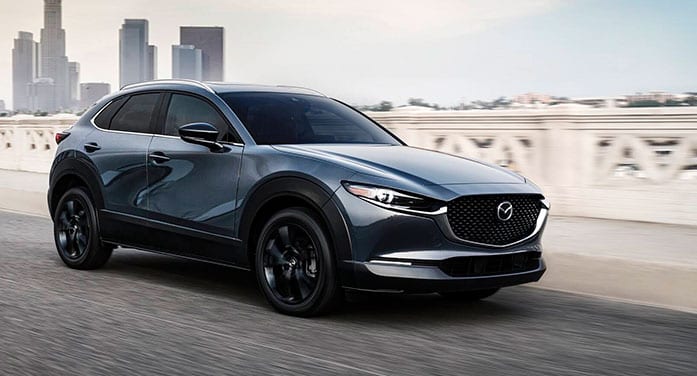 Sometimes it seems like every other vehicle on the road is a Mazda. Specifically, one of the CX models: 3, 5 or 9. These are very popular SUVs and I’ve driven most of them at one time or another.
Sometimes it seems like every other vehicle on the road is a Mazda. Specifically, one of the CX models: 3, 5 or 9. These are very popular SUVs and I’ve driven most of them at one time or another.
The CX-5 is the sixth most popular compact SUV sold in Canada, behind perennial leaders Toyota RAV4 and Honda CR-V (not necessarily in that order), and the Ford Escape, Nissan Rogue and Hyundai Tucson.
This is a very competitive market and the fact that the CX-5 is in the top 10 really says something about its appeal. If you threw all the CX models into the mix, you’d probably find that Mazda sells more compact SUVs in Canada than anyone.
But Mazda isn’t leaving well enough alone and recently added yet another compact SUV to its stable: the CX-30, which is available in a newly-minted turbo variant, which I drove recently.
| RELATED CONTENT | |
| Mazda CX-30 for 2022 is familiar and functional By Ted Laturnus |
|
| Tuning out the Mazda CX-5 because of a stubborn radio By Ted Laturnus |
|
| Driver-friendly Mazda CX-5 is easy to get along with By Ted Laturnus |
|
|
Power is provided by a 2.5-litre four-cylinder engine that has what Mazda calls a “dynamic pressure” turbocharger. This engine is a $2,400 option and – in normally aspirated form – is used elsewhere in the company’s lineup. In this configuration, it develops 227 to 250 horsepower, depending on the grade of fuel – fill up with premium and you get almost 25 additional horses and 10 more foot pounds of torque.
Transmission is six-speed only and the CX-30 has all-wheel drive.
If the CX-30 feels like the CX-3, that’s because it’s pretty much the same vehicle. It has about the same dimensions and offers 1,280 litres of cargo space, with the second row seats folded. The CX-3 has slightly less: 1,260 litres (44.5 cubic feet). A Honda CR-V has 2,146 litres, while the Hyundai Tucson offers 1,754 litres.
Like the CX-3, the CX-30 is pleasant to drive – with some caveats. It has a well-thought-out driving position and ingress/egress is straightforward. Road noise is under control, and fuel economy is okay but not noteworthy. I also liked the heads-up display, which is used by Mazda in many of its SUVs.
The good
- Power delivery is seamless. Turbo boost blends in well under hard throttle and the CX-30 is a lively performer. Not overwhelming, but usable and easy to get along with.
- It has well co-ordinated suspension, with a couple of settings. The CX-30 seems to handle and behave better than the CX-3, for example.
- Equipment level is remarkably high. For its $36,000-plus price tag, the CX-30 has just about everything you could ask for. For example: heated steering wheel, power rear tailgate, three-setting heated front seats, steering wheel paddle shifters, rain-sensing wipers, hill descent control, and on and on. Plus it has the usual nanny features such as lane departure warning, pedestrian warning, rear-view camera and distance-sensing cruise control.
The bad
- I know I tend to go on about this, but Mazda’s switchgear sucks. Particularly the radio/audio controls. I suppose one would get used to it eventually, but I’ve driven just about everything in the company’s lineup over the past few weeks and I never did. This is the CX series’ biggest flaw and the design team responsible for the stereo system needs to be spoken to.
- The push-button start can be fussy. Now and again, the car doesn’t start right away and you have to shut it off and do it again. It’s not a big deal but it is annoying.
Would I buy this one?
It represents good value for the money but the little things would probably drive me crazy.
Mazda CX-30 Turbo
Engine: 2.5 litre turbocharged four-cylinder
Transmission: six-speed
Drive: all-wheel
Horsepower: 227 to 250 at 5,000 rpm
Torque: 310 to 320 at 2,000 rpm
Price as tested: $38,400
Fuel economy: 10.5 litres/100 km (city) and 7.5 litres/100 km (highway), with regular or premium gas
Some alternatives: Hyundai Tucson, Honda HR-V, Honda CR-V, Toyota RAV4, Nissan Qashqai, Volkswagen Tiguan, Kia Sportage, Mazda CX-3, Subaru Crosstrek
Ted Laturnus writes for Troy Media’s Driver Seat Associate website. An automotive journalist since 1976, he has been named Canadian Automotive Journalist of the Year twice and is past-president of the Automotive Journalists Association of Canada (AJAC).
For interview requests, click here. You must be a Troy Media Marketplace media subscriber to access our Sourcebook.
The views, opinions and positions expressed by columnists and contributors are the author’s alone. They do not inherently or expressly reflect the views, opinions and/or positions of our publication.
COMMUNITY NEWS OUTLET ACTION PLAN!
WEBSITE HOSTING AND ALL TROY MEDIA EDITORIAL CONTENT POSTED TO YOUR SITE DAILY FOR ONLY $129.95 PER MONTH.
Limited time offer: Get your first 2 months FREE! Click here for details




